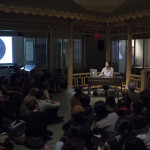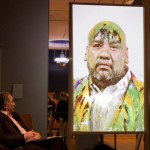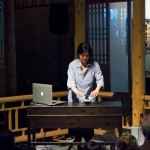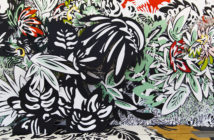But why describe the events that took place during Onto Objects? You had to be there. What lasts beyond the singular moment of each performance, which can be imparted to a reader, are impressions, thoughts, and lingering questions.
Museum / Mausoleum
You remember this saying from somewhere: museums are the place where art goes to die. According to Google3, it is attributable to British philosopher Alan Watts (no context offered), but ever reliable Theodor Adorno, in his essay Valéry Proust Museum, had more to say on the subject:
"The German word 'museal' [museumlike]has unpleasant overtones. It describes objects to which the observer no longer has a vital relationship and which are in the process of dying. They owe their preservation more to historical respect than to the needs of the present. Museum and mausoleum are connected by more than phonetic association. Museums are like the family sepulchres of works of art. They testify to the neutralization of culture."
During Onto Objects, I witnessed that the weight this statement has claimed in our collective artistic unconscious could be cast off by sound; that the process of dying could be slowed, perhaps even temporarily undone, through the performance of contemporary rituals ("needs of the present"), in which one artist acknowledges another, in which the object as evidence of another human hand, mind, breath, is enlivened through a new kind of use. In a suit with sleeves adorned with hundreds of small metallic cones, which rattled and shook as he moved about the room, Gibson drummed. He played for Pollock's bowl, Flight of Man, he played for Troubled Queen, he played for No.10. And, I kid you not, for the first time ever, I felt moved by Pollock's work, because, for once, it seemed to give a little back.
The warmth of human bodies had suffused the study, surrounding Patty Chang as she opened her shirt and fastened two empty storage bottles to two breast shields. She carried on lecturing as the pump did its work, with the slightest look of discomfort on her face. In the video projections that framed her, we watched her sponge water onto a beached whale, with increasing confidence, patience and devotion. We watched her bounce a baby in a carrier, to and fro, standing at the bedside of what looked like a dying man. She talked and talked about Shangri-La, and the work she had made on the subject, a subject of lore and legend, whose most physical manifestation, which she had documented extensively, now smolders.
Theatrical Time
In scripting their performances, Chang and Gibson brought to two galleries, designed to celebrate certain works of art through formal or chronological juxtapositions, a kind of nuance they generally lack. Barebones staging and props--the breast pump, an antique chaise longue--sufficed to suggest a collision of public and private space: we were privy to intimate activities which belong to the home or the doctor's office. The subjectivity and specificity of each act heightened the pre-existing theatrics of museums, their pristine, simulated decors, their dramatic spot lighting, and how these strip the art object of its often humble human origins. The artists' amplified voices funneled stories, memories, and histories of vulnerability and loss into the spaces we occupied. Time felt more and more compressed as official narratives overlapped with personal ones, confusing linear progressions of cause and effect, then and now.
 Jeffrey Gibson, Timeline 1.29.14
Jeffrey Gibson, Timeline 1.29.14"Onto Objects", 29 January 2014, Museum of Fine Arts Boston
Photo: Eduardo Restrepo
Gibson cast an art critic as the psychoanalyst, and invited Dennis Carr, Lynch Curator of American Decorative Arts to play a cameo role as himself. After drumming, Gibson reclined on the antique chaise longue and explained to the phony analyst4 that he had called on the spirits of the objects. Each, as he introduced them, was different: some angry, anxious and frightened, others bombastic and pugnacious. These biographies felt predictable and rehearsed, far less spontaneous than the music that had preceded them. And the illusion that the therapy session might have been candid once lost, all the questions the psychoanalyst put to Gibson began to sound leading and hollow. More cogent and touching was Gibson's expressed resentment toward Jackson Pollock and what he represents, officially the poster child of the first American art movement, and, unofficially, the embodiment of everything Gibson was taught to shun owing to stereotypical perceptions of Native Americans as prone to violence, drink, and animalistic urges.
Ultimately, leaving aside the (surprised, relieved or knowing) laughs garnered from Gibson's professed dislike of Pollock, his performance, Timeline 1.29.14, warned that the narratives and presentations we construct to relay our art histories are personally damaging to the individuals whose cultures they may deliberately overlook. In every way, Patty Chang's final gesture in Flash Burn in Uzbekistan also felt like a balm on a wound. After filling two bottles with breast milk, she unfastened the tubes, buttoned up her shirt, and carefully poured their contents into a small dark bowl on the table before her, which brimmed as the last drops hit the surface. I thought "what a waste..." until I looked around the room, and understood the offering she had just made.
[1] Recent examples include Marilyn Arsem's With The Others and Sandrine Schaefer/Philip Freyer's Untitled View performed at the MFA for "Odd Spaces," also curated by Liz Munsell, Time, Body, Space, Objects 2 at Anthony Greaney Gallery, and Eduardo Restrepo for Todo Bajo Contról at Villa Victoria for the Arts.
[2] "James Hilton's 1933 novel Lost Horizon tells the story of an intrepid but alienated British diplomat, Hugh Conway, who, after a plane crash, finds himself stranded in the Tibetan lamasery of Shangri-La. Soon enough, though, Conway discovers the mysteries of this "heaven on earth," whose inhabitants are graced with extreme longevity. The monks, anticipating cataclysmic disaster in the outside world, plan to preserve knowledge and civilization for future generations within the confines of their peaceful land. Lost Horizon was a best seller and put Hilton's myth of a Shangri-La into wide circulation, followed in 1937 by the equally popular film adaptation by Frank Capra. Sixty years later, in 1997, a rural Chinese town named Zhongdian, in Yunnan province near the Tibetan border, declared itself to be the place upon which Hilton's Shangri-La was modeled. This pronouncement was motivated by the hope of attracting tourists from the newly wealthy Chinese middle class; a dozen other towns in the region immediately followed suit in claiming the distinction, thereby precipitating a marketing battle that came to be known as the "Shangri-La war." The ensuing chaos eventually compelled the Chinese government to intervene and it ended the conflict by acknowledging Zhongdian as Shangri-La, thereby granting official recognition of the town as the "real" location of a completely fictional place." From newmuseum.org
[3] Inside joke for those present at Patty Chang's performance.
[4] Jackson Pollock underwent analysis beginning in the late 1930s, and was interested in Jungian theory in particular. Source: mfa.org










